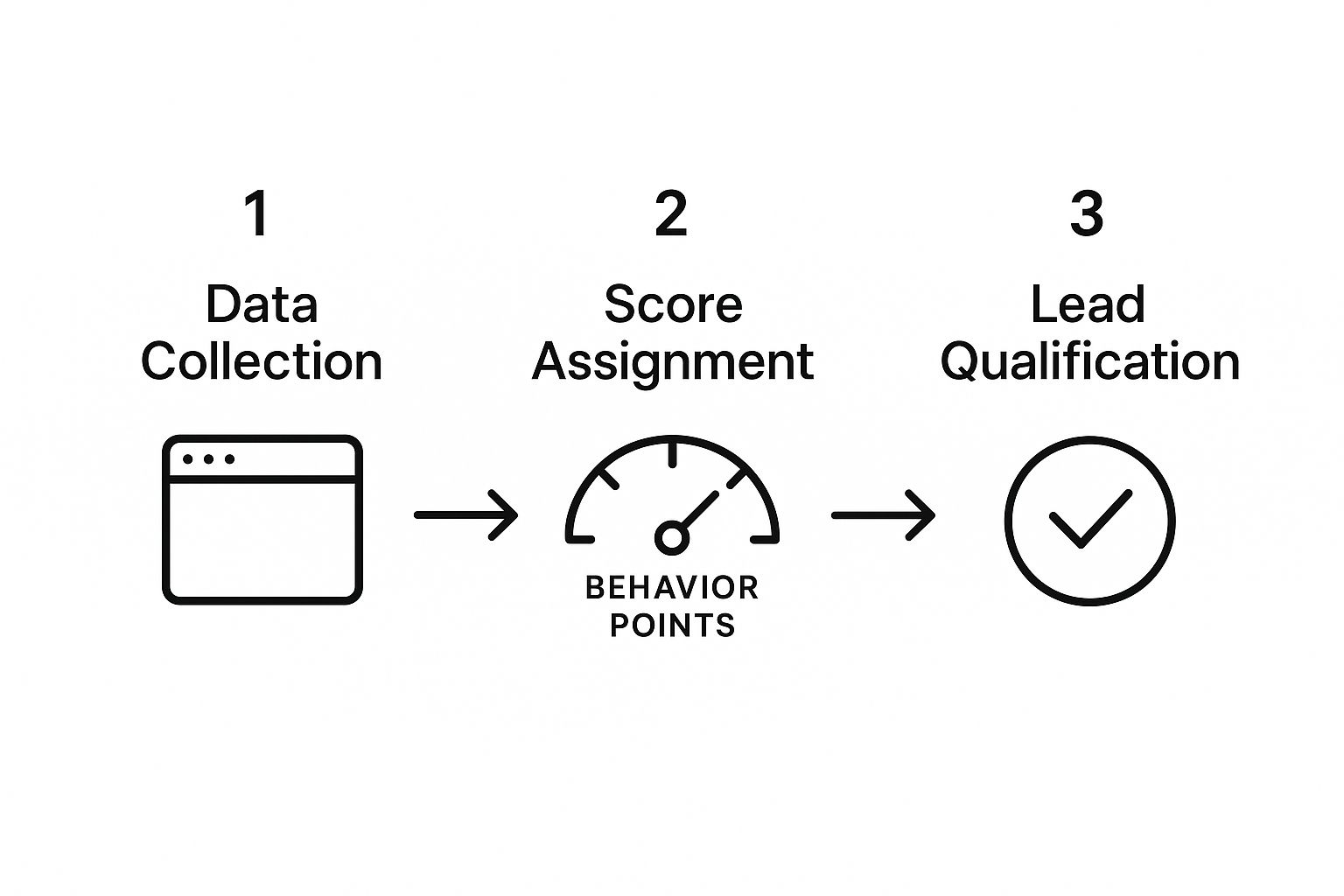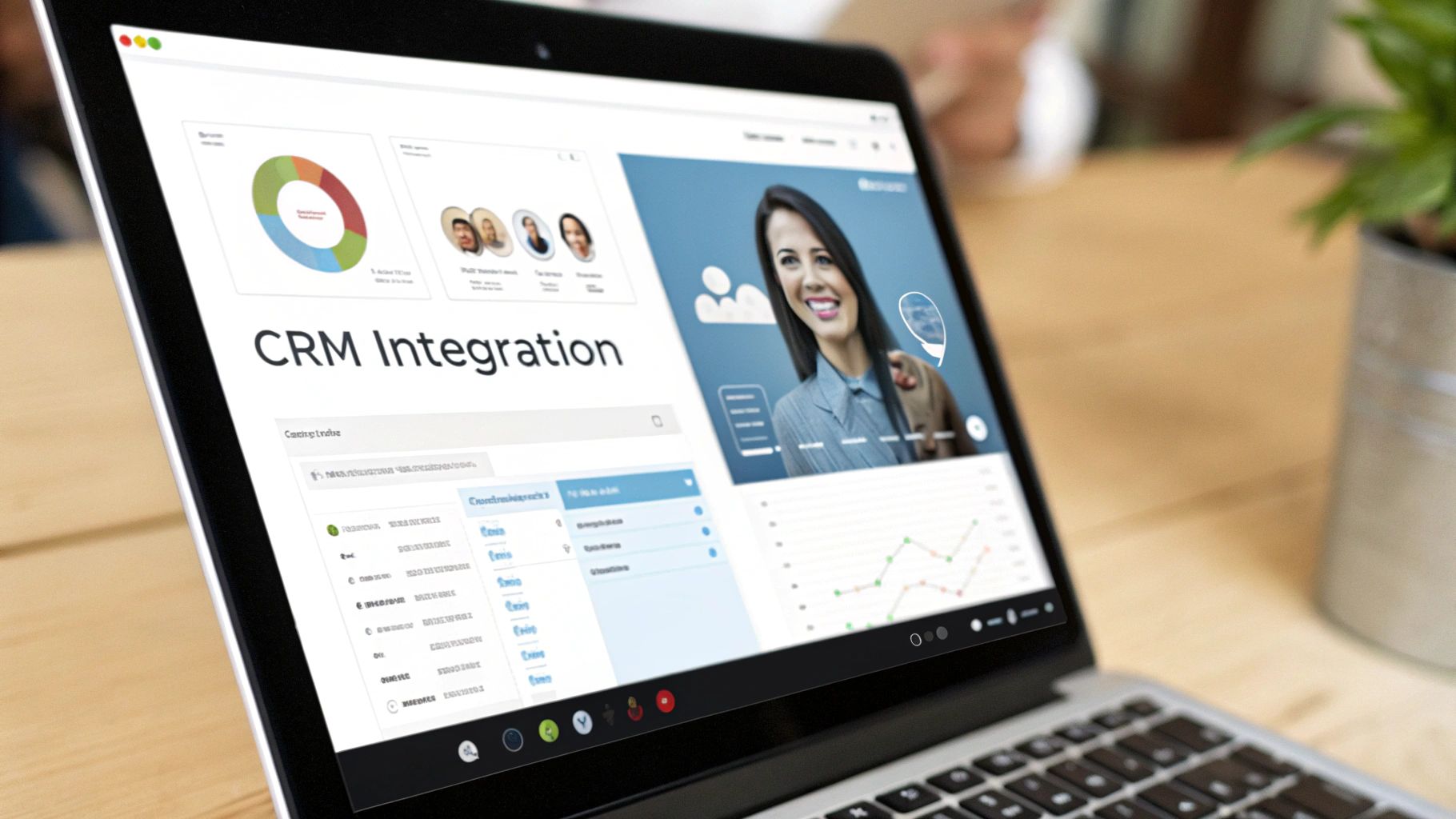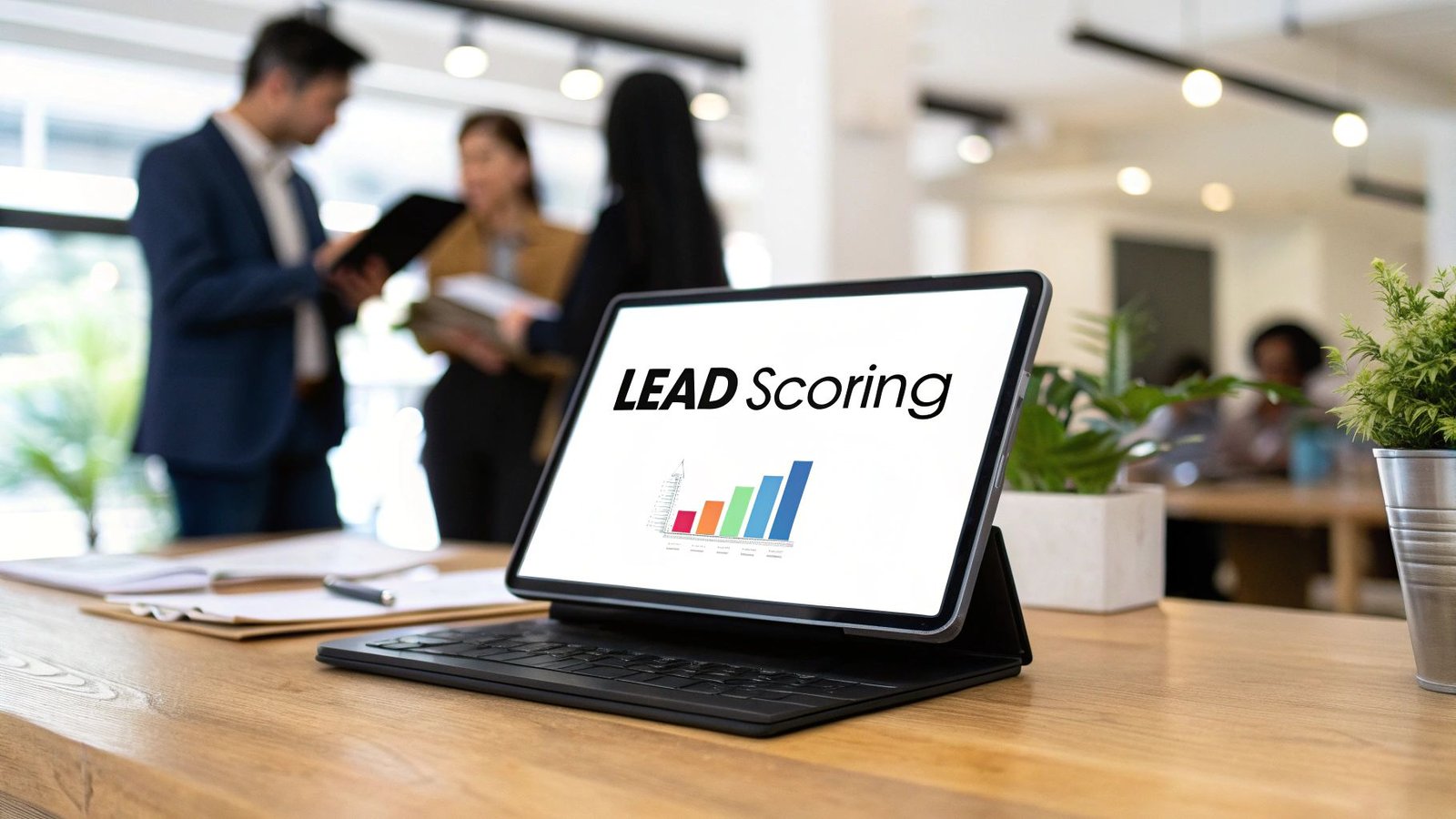Think of your incoming leads as a giant pile of mail. Some of it is junk mail, some of it is bills, but a few letters are personal invitations or important notices. How do you decide which to open first? You look for clues, right? That’s exactly what lead scoring does.
Lead scoring is a system for ranking your potential customers by assigning them a numerical value, essentially telling you how "ready" they are to buy. Instead of treating every single person who shows a glimmer of interest the same way, this system helps your sales and marketing teams focus their precious time and energy on the leads most likely to become customers. It’s all about working smarter, not harder.
What Is Lead Scoring and Why Does It Matter?

Imagine your sales team at a huge networking event. Without a plan, they'd have to talk to every single person, wasting hours on conversations that lead nowhere. Lead scoring is like having a secret guide who whispers, "See that person over there? They've been asking all the right questions. Go talk to them." It points your team directly to the folks who are genuinely interested and ready for a real business conversation.
This methodical approach is the critical bridge connecting your marketing activities to actual sales results. It ensures that the leads your marketing team works so hard to generate are properly vetted before they ever land on a sales rep's desk. By creating a clear, data-driven system, everyone on both teams finally agrees on what a "good" lead actually looks like.
The Core Idea Behind the Score
At its heart, lead scoring is built on a simple truth: not all leads are created equal. A startup CEO who downloads your pricing guide is worlds apart from a college student who stumbles upon a single blog post. The system assigns points based on specific actions and attributes that signal real buying intent.
To give you a clearer picture, here’s a quick breakdown of what goes into a typical lead scoring model.
Lead Scoring at a Glance
| Component | What It Represents | Primary Goal |
|---|---|---|
| Demographic Scoring | How well a lead fits your ideal customer profile (job title, company size, industry, location). | To identify if they are the right person from the right company. |
| Behavioral Scoring | Actions a lead takes that show their level of interest (visiting pricing pages, downloading guides, attending webinars). | To measure their engagement and buying intent. |
| Negative Scoring | Actions or attributes that decrease a lead's score (visiting the careers page, being a competitor). | To filter out unqualified or low-priority leads. |
By combining these elements, you get a powerful, at-a-glance understanding of each lead's potential.
So, what’s the real-world payoff? Implementing a solid scoring system brings some major wins:
- Sky-High Sales Efficiency: Your team stops wasting time on dead-end leads and spends more time having meaningful conversations with genuinely interested prospects.
- True Marketing and Sales Alignment: Both teams finally operate from the same playbook, with a shared definition of a "qualified lead." This smooths out the handoff process and eliminates a ton of friction.
- Smarter Personalization: Knowing a lead's score gives you context. It helps you tailor your emails and calls, making your outreach far more relevant and effective.
Lead scoring is the ultimate filter for your sales pipeline. It cuts through the noise, separating the real opportunities from the distractions. This allows you to put your best resources where they’ll make the biggest impact on your bottom line.
This strategy is no longer a niche tactic; it’s a standard practice for high-performing sales and marketing teams. As of 2024, around 44% of companies reported using scoring methods to sort and prioritize their leads. This shows just how essential it has become for navigating the modern B2B SaaS sales funnel.
Understanding Your Lead's Digital Footprint

Every potential customer leaves a trail of digital clues as they interact with your brand. Think of it as a footprint—a record of where they've been and what they've done. Learning to read this footprint is the key to understanding lead scoring in the real world.
This trail is made up of two different kinds of information. When you put them together, you get a surprisingly clear picture of who's just browsing and who's a serious potential buyer.
The first part of the puzzle is explicit data. This is the information a lead gives you directly. It's the stuff they fill out in a form—their job title, company name, industry, or location. Essentially, it tells you who they are and if they match the profile of your ideal customer.
Reading Their Digital Body Language
While explicit data gives you the hard facts, implicit data reveals what’s really on their mind. This is all about their behavior—the actions they take when they interact with your website, emails, or content. It’s their "digital body language," and it tells you what they're doing.
These actions are massive indicators of interest and form the backbone of any good scoring system. Here are a few examples of what to look for:
- Website Visits: Are they repeatedly visiting your pricing page, or did they just land on a single blog post and leave?
- Content Downloads: Did they download a top-of-funnel ebook or a bottom-of-funnel case study that gets into the nitty-gritty?
- Email Engagement: Do they open every email you send and click on your links, or do they ignore most of them?
- Webinar Attendance: Did they sign up for and actually attend your live product demo?
Every action tells a piece of the story. A visit to the pricing page is a much stronger signal than a quick glance at your blog. By tracking these behaviors, you can see where someone is in the SaaS customer journey and figure out how close they are to making a decision.
By combining the "who they are" (explicit data) with the "what they do" (implicit data), you move beyond simple demographics. You gain a holistic view of a lead’s sales-readiness, allowing you to prioritize with confidence.
Ultimately, a well-built lead scoring model works like a detective, putting all these clues together. This combination makes sure your sales team isn’t just chasing leads who look good on paper but is spending their time on people who are actively behaving like future customers. That's how you deliver truly qualified leads.
How to Build Your First Lead Scoring Model
Diving into your first lead scoring model can feel intimidating, but you don't need a data science degree to get it right. Think of it like creating a recipe for your ideal customer. You're just identifying the right ingredients (their attributes and behaviors) and figuring out the right measurements (the points you assign) to cook up a perfectly sales-ready lead.
This visual breaks down the core stages, from gathering that initial data to the moment a lead hits the magic number and gets passed to sales.

As you can see, it's a journey. It starts by collecting key info, moves on to assigning value to what a lead does, and ends when they cross the qualification threshold your team has decided on.
Define Your Ideal Customer Profile
Before you can score a single lead, you have to know what a "perfect 10" actually looks like for your business. This all starts with nailing down your Ideal Customer Profile (ICP) and detailed buyer personas. Who are you really trying to sell to?
Get granular about what makes your best customers tick. Look at things like their job title, the size of their company, their industry, and where they're located. This isn't just an exercise; it's the foundation of your entire model. It ensures you're scoring to find more of the people you already know are a fantastic fit. For a deeper look, check out this guide on how to create buyer personas.
Identify Key Attributes and Actions
Next, it’s time to brainstorm. Make a list of all the explicit details and implicit behaviors that scream "good lead." The best way to do this? Grab your sales team and ask them what signals they look for in the wild. They know what a promising opportunity feels like.
Your list will probably include a mix of criteria like these:
- Explicit Data: Their job title is "Director" or higher, the company has over 100 employees, or they work in the Technology industry.
- Implicit Data: They visited your pricing page, downloaded a case study, or sat through an entire product webinar.
Your real goal here is to turn your team’s gut feelings and anecdotal evidence into a concrete, data-driven checklist. A "demo request" is a massive buying signal, worlds apart from a simple newsletter signup, and your scoring needs to reflect that.
Assign Points and Set a Threshold
Now for the fun part: assigning points. High-value actions—like requesting that demo—should get a hefty score, maybe +25 points. Lower-intent actions, like opening an email, are still good but might only be worth a couple of points, like +2 points. You'll do the same for the explicit data that matches your ICP.
Finally, you need to decide on a threshold. This is the score that officially turns a prospect into a Marketing Qualified Lead (MQL) and triggers the handoff to sales. Pick a starting number that feels right, and don't be afraid to adjust it. Over time, feedback from sales and your own conversion data will tell you exactly where that magic number should be.
Putting Lead Scoring Into Practice: A Real-World Example
Alright, let's move from theory to action. It’s one thing to talk about explicit and implicit data, but it's another to see how it all comes together in a real scoring model.
Think of it like a game where leads earn points for who they are and what they do. Once a lead hits a certain score, say 100 points, a light goes off, and your sales team knows it's time to reach out.
A Sample Scoring Template
So, how do you decide what’s worth 5 points versus 25? Let’s imagine we're a B2B software company and build a simple model. The trick is to give more weight to the actions and traits that signal a real intent to buy.
For instance, someone requesting a demo is way more valuable than someone just opening a newsletter. One is actively kicking the tires; the other is just browsing.
Here’s a quick look at how you could assign points. This is just a starting point, but it shows how you can blend different types of information to get a complete picture of a lead.
Example Scoring Attributes and Points
This table breaks down how you might score different attributes for that B2B software company we mentioned. Notice how high-value demographic data (like a C-level title) and high-intent behaviors (like visiting the pricing page) earn the most points.
| Attribute Type | Scoring Criteria | Example Points |
|---|---|---|
| Explicit (Firmographic) | Job Title (VP or C-Suite) | +20 |
| Company Size (Over 200 employees) | +15 | |
| Industry (Matches your ICP) | +10 | |
| Implicit (Behavioral) | Requested a Demo | +25 |
| Visited the Pricing Page | +15 | |
| Attended a Webinar | +10 | |
| Downloaded a Case Study | +5 | |
| Opened a Marketing Email | +2 |
As you can see, this balanced approach helps you focus on two things at once: finding the right people and finding the people who are most engaged right now.
By setting up a clear scoring system like this, you take the guesswork out of lead qualification. Gut feelings are replaced with a hard number, giving both your marketing and sales teams a clear, objective signal they can trust and act on.
The Future of Scoring with AI

While setting up a manual, rules-based scoring system is a fantastic start, the next chapter in lead scoring is already being written by artificial intelligence. AI is what takes a good system and makes it a genuinely smart one.
Think of a scoring model that doesn't just follow your instructions but actually learns and gets better on its own. That's the core idea behind predictive lead scoring. Instead of you setting the rules, it dives into all your historical data—every single win and loss—to figure out the complex patterns that truly point to a future sale.
This AI-powered approach sees things we often can't. It can uncover subtle connections that a human analyst might easily overlook. For example, it might discover that leads from a certain industry who download a specific whitepaper and then visit your pricing page twice are almost guaranteed to convert. AI spots that connection and adjusts scores on the fly.
Moving Beyond Human Bias
One of the biggest wins with AI in lead scoring is its ability to stay objective. Let's be honest, manual models can sometimes be shaped by outdated assumptions or a bit of "gut feeling" from the sales and marketing teams.
AI cuts right through that. It relies purely on the data, making sure every lead is judged based on what has actually worked in the past, not on what someone thinks should work. This data-driven method builds a far more accurate and dependable system from the ground up.
Predictive lead scoring uses machine learning and vast amounts of historical data to assign scores that forecast a lead's likelihood of converting. It's not just about tracking what they did; it's about predicting what they'll do next with incredible accuracy.
This isn't just about better accuracy; it's about better results. Research shows that companies using this technology see an average 25% increase in conversion rates thanks to the precision of AI scoring. You can dig deeper into predictive scoring findings at Coefficient.io.
Continuous Learning and Real-Time Adaptation
Your market is always changing, and so are your customers. A major drawback of a manual scoring system is that it's static—it needs constant check-ins and updates to stay relevant.
AI models, on the other hand, are alive. They are constantly learning from the new data that comes in every day. If a new marketing campaign suddenly starts pulling in a completely different type of high-value lead, the model sees it and adapts in real time. This keeps your scoring system perfectly tuned, giving you a smarter, more agile edge in understanding what is lead scoring at its most powerful.
Got Questions About Lead Scoring? We've Got Answers.
As you start digging into lead scoring, you’re bound to have some questions. That's a good thing. Figuring out the practical details upfront is the key to building a scoring system that actually works—one that doesn't just look good on paper but delivers real results.
Let's walk through a few of the most common questions that come up when teams first dip their toes into the water.
Is My Company Too Small for This?
I hear this one all the time, and the answer is almost always a resounding no. Lead scoring isn't some complex system reserved for giant corporations with lead lists a mile long. The truth is, even a small, scrappy team can gain a massive edge by knowing which prospects are genuinely interested and a good fit.
Here’s a simple test: does your sales team have more leads than they can follow up with right this second? If the answer is yes, you're ready. The whole point is to make your team more efficient, and that’s just as critical for a sales team of two as it is for a team of two hundred.
How Often Do We Need to Tweak the Model?
A lead scoring model is not a slow cooker—you can't just set it and forget it. Your business is always changing, your market is shifting, and your customers' needs are evolving. Your scoring model has to keep up.
Think of your lead scoring model as a living, breathing part of your sales process. It needs regular check-ups to stay healthy and accurate, making sure it reflects what's actually happening on the ground.
As a starting point, plan to review your model at least once a quarter. This isn't just about looking at a dashboard; it’s about getting real feedback.
- Chat with your sales reps: Are the "hot" leads you're sending them actually hot? Their feedback from the front lines is pure gold.
- Dig into the conversion data: Take a hard look at the leads that became customers. Do their scores and behaviors match what your model predicted?
- Examine the "duds": Did any low-scoring leads end up buying from you? If so, you might have a blind spot in your criteria that needs fixing.
When Is a Lead Actually "Sales-Ready"?
This is the million-dollar question: what's the magic score that turns a lead into a Marketing Qualified Lead (MQL) ready for sales? There's no one-size-fits-all answer here. The right threshold is unique to your sales cycle, your product, and your team's bandwidth.
A great place to start is by looking back. Analyze the scores of your best customers right at the moment they were passed over to sales. That historical data gives you a solid, evidence-based starting point. Set an initial score based on that, then watch what happens. It's a process of testing and tweaking, and it absolutely requires an open line of communication between marketing and sales.
Getting this right is worth the effort. The data shows B2B companies that use lead scoring see a 77% increase in their lead generation ROI. Still, only 44% of organizations are actually using a scoring system to sort their leads. That gap represents a huge opportunity for any company willing to dive in. You can learn more about the impact of lead scoring at LLCBuddy.com. By answering these questions first, you’re already on your way to closing that gap.
